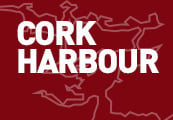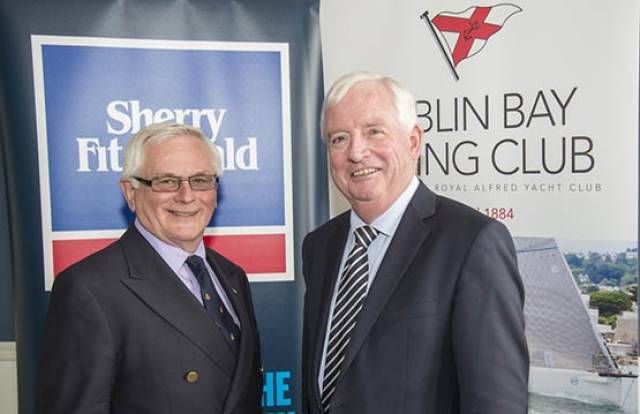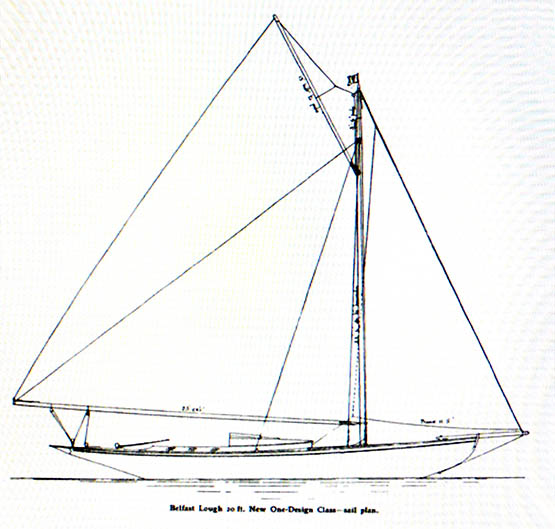The 133rd annual racing programme of Dublin Bay Sailing Club was unveiled yesterday in the National Yacht Club in Dun Laoghaire, and it brought the announcement by incoming Commodore Chris Moore that the club had secured a strong three year sponsorship commitment with leading property and estate agents Sherry Fitzgerald. DBSC is a unique organisation which ultimately is the co-ordinator of all non-offshore racing from Dun Laoghaire, and it provides more sailing for more people than any other club in Ireland. W M Nixon reflects on a very durable institution, and the way the changes are being communicated for its “users” in 2016.
It was said somewhere recently that the most successful and enduring organisations are those which, at any given time, are neither necessarily the strongest, nor the cleverest, nor the most powerful shows in town. But they definitely are the setups which are adjusting most readily to change, and making the best of it to real advantage.
At first glance, that seems most perceptive. At second glance, it seems like the latest statement from the President of the IBO (the Institute of the Bleeding Obvious). And at third glance, you wonder just what on earth whoever said it thought they meant by “strongest”, “cleverest” and “most powerful”, when the main point of most organisations in human society is that they should at the very least endure for a useful timespan, and if through enduring they thrive, then that is as it should be.
These thoughts were already in place on the screen when some briefing notes about the Dublin Bay SC programme for 2016 arrived in from Honorary Secretary Donal O’Sullivan, and as ever the great man had put the above maunderings into a much more concise form. In outlining some quite marked changes to the way DBSC will be doing things during 2016, he states the Club’s philosophy as one of being proactive with evolution, rather than reactive to revolution.
The latest stage in this process of being proactive with evolution came yesterday, when the National YC was the setting for a lunch hosted by DBSC Commodore Chris Moore for the official announcement of the DBSC’s linkup with Sherry Fitzgerald. They may be distinguished estate agents with a strong national presence, not to mention an international profile, but “Sherry Fitz” are particularly associated with the more agreeable areas of south Dublin.
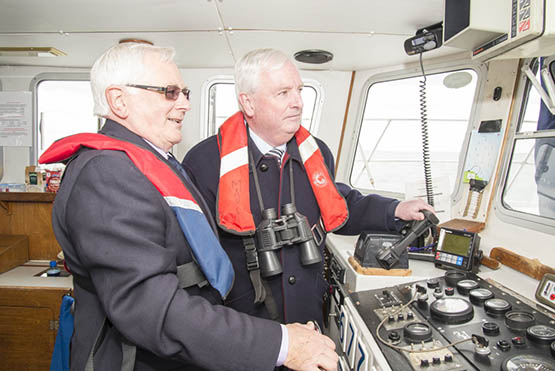
The bay on display – Chris Moore and Philip Sherry in command as DBSC’s Mac Lir takes a tour of the harbour and Dublin Bay’s racing area. Photo: Brendan Fogarty
Therefore the company and its new sponsorship partners are fishing in the same waters, but they’re providing services of a very different kind which are totally complementary to each other. So really we were celebrating, at the very least, the beginning of a beautiful friendship, and by the time lunch ended, it was toasted as a marriage made in heaven.

The bay’s history put in perspective – DBSC Honorary Secretary Donal O’Sullivan and Philip Sherry of Sherry Fitzgerald aboard Mac Lir on Dublin Bay. Photo: Brenda Fogarty
This was in evidence in a good-humoured, friendly and mutually-informative gathering in which Philip Sherry and his team got to know more about what it is that DBSC actually does. In order to give the broader picture, before lunch there was a quick tour of the harbour and nearer parts of Dublin Bay aboard the DBSC’s senior workhorse, the Committtee Boat Mac Lir. From her, we could see the always-fascinating panorama of the Dun Laoghaire waterfront. The fleet had already launched last weekend en masse from the National, while the Royal St George’s YC fleet were poised for their launching today, with a mighty crane already set up on the quayside. In one glance, you got a very telling impression of the boat numbers – and the diversity – with which DBSC has to deal with in their annual programme, which in 2016 starts on Tuesday 26th April, and concludes on Saturday 24th September.
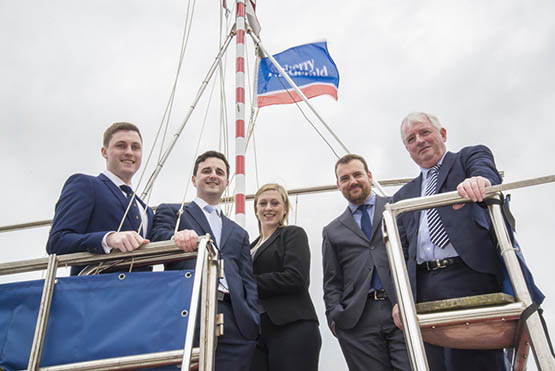
A new flag aloft. Chris Corrigan (left, DBSC Committee) with (left to right) Sherry Fitzgerald’s Patrick George, Miriam Mulligan, Steven Manek, and Philip Sherry. Photo: Brendan Fogarty

“Here’s a photo I got out on the bay” – in the National YC are (left to right) Philip Sherry, Miriam Mulligan and Patrick George of Sherry Fitzgerald with Jonathan Nicholson, Vice Commodore DBSC. Photo: Brendan Fogarty

Stephe Manek of Sherry Fitzgerald with Chris Moore. Photo: Brendan Fogarty
Throughout the season, the overall numbers are at such levels, expressing themselves through so many classes and divisions, that it takes a well-furnished mind to clearly dispense the key information in the DBSC 2016 Yearbook, with its myriad of instructions and attached information.

Committee minutes. DBSC Committee Member Dr Brendan Finucane with Honorary Secretary Donal O’Sullivan and Committee Member Sean Doyle. Photo: Brendan Fogarty

Patick George and Miriam Mulligan of Sherry Fitzgerald
As you’d expect of a man who can reduce such complex concepts to their bare essentials, Honorary Secretary Donal O’Sullivan is completely matter-of-fact in reporting on the waxing and waning in the fortunes of Dublin Bay’s many and various one-design and handicap cruiser classes. But underneath it all, he’s human. Having bluntly informed us that the planning of the new programme has had to take account of the decline in “traditional” boat numbers – when traditional boats include classes like the Dragons – you feel a certain warmth in his words when he writes:
“There is one notable exception to all this. The Water Wags, that quintessential traditional boat, continue against the trend to grow in numbers. Last year, with 29 boats actively on the register, they were probably even more numerous than they were in their Victorian heyday. The Water Wags have always had an active preservation programme, allied with a strong class ethos or esprit de corps to help them grow and flourish”.
The underlying message is that while Dublin Bay SC can continue to develop and refine their racing structures on the bay - despite it becoming an ever more busy place with the volume in the shipping lane into Dublin Port up by 6.4% in 2015 - at each class level it is now up to the class members – with the Class Captains setting the pace - to show the right spirit in keeping their boat numbers and their sport at a healthy level.
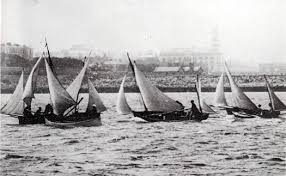
Early days. The Dublin Bay SC club “fleet” in racing action its first season, 1884
The Club’s inherited experience of encouraging boat classes is unrivalled. And at one stage of its long existence, it was in the business of direct class promotion itself. Though it came into existence with a ragbag little fleet of open boats in 1884, its efficient race administration - and maybe the fact that it had such a no-nonsense name that enabled it to do what it said on the tin - soon saw it spreading into every corner of racing in Dun Laoghaire, and going very rapidly up the social scale as it took over general racing administration from the three established clubs in their stately clubhouses.
By the 1890s, it was in the forefront of international sailing development. The unique position of Dun Laoghaire as the only outlet for the maritime energies of affluent south Dublin provided DBSC with a ready market, which in turn created a level of activity which became increasingly attractive to people from all over Ireland and beyond.
With its powerful focus and the financial muscle of its members, DBSC was able to take on board good ideas from near and far, and develop them further. Thomas Middleton of Killiney Bay may have introduced the One-Design concept for boat racing in 1887, but he concentrated on very small sailing boats. DBSC, on the other hand, was very soon showing what could be done with the One-Design ideal in larger sizes.
And even with specific boats, they took concepts from other centres, and developed them further. In July 1897, four yachts of the new and ultra-pioneering William Fife-designed Belfast Lough Class I One-Designs came to Dublin Bay, and took part in the regatta week. At 37ft overall and with 25ft waterline, these remarkably good-looking boats represented a real breakthrough in sensible yacht design and the One-Design ideal.
By the following year, the first of the Fife-designed Dublin Bay 25s – with the same hull profile and dimensions as the Belfast Lough boats, but with a slightly finer midships section, and built to a higher specification – were already racing. Within a very few years, they outnumbered the Belfast Lough boats. Within a few decades, everyone marvelled at the Dublin Bay 25s, whose adherents at one stage had included the Viceroy himself. But few remembered the Belfast Lough Class I boats, let alone that they had been first on the scene.
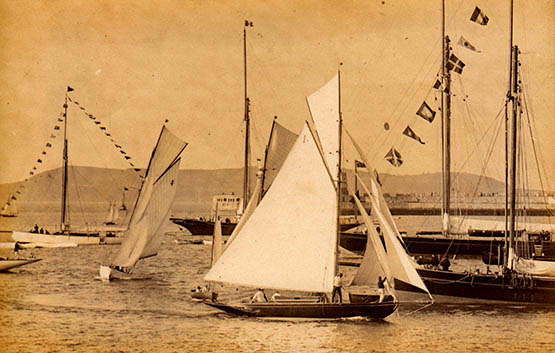
The height of fashion. It’s around 1900, and the Viceroy Lord Dudley is taking a lap of honour around the harbour after winning in his new Dublin Bay SC 25-footer Fodhla (number 1). Also in the mix are some Mermaids to the new design by Maimie Doyle.
Around 1900, the Belfast Lough men had retained the new designer in Scottish sailing, Alfred Mylne, to provide a simple boat around 20ft waterline with an economical gunter-lug sloop rig, the Star Class. The Dublin Bay magpies saw what resulted, and they liked it. But they got Mylne to make the stem a bit more elegant, and instead of the prosaic gunter sloop rig, they got him to design a rakelly gaff cutter complete with outrageous jackyard tops’l.
The result was the Dublin Bay 21, which pretty well defined Dublin Bay sailing for much of the 20th Century, with its northern origins forgotten. It was a classic case of what is in effect the capital of Irish sailing quite happily allowing another area to develop a good idea, but then cheerfully taking it on board and adapting it into a much more vibrant form.
Nowadays people may still argue that the Dublin Bay 21 was actually a more useful all-round boat with its later and simpler Bermudan rig configuration from 1963 until the class ended in 1986, but the reality is that the sheer off-the-wall style of the DB 21s with their full rig for sixty years from 1903 to 1963 was the image which best projected the spirit of sailing in Dublin Bay.
“A very sensible boat with an economical rig” – this was the new Alfred Mylne-designed Star Class as it appeared on Belfast Lough in 1900………

……and this is what happened to the Star when the DBSC took the idea on board, but decided to make her a little bit more challenging to sail, with an extravagant rig. The Dublin Bay 21 as she was in her glory days from 1902 to 1963.
In fact, the Dublin Bay SC machine was and is so powerful that they can sail on with a sort of sublime indifference to the intellectual property rights of other sailing centres when new concepts come along. Once something has become a Dublin Bay thing, it is subsequently known in Dun Laoghaire solely as a Dublin Bay thing. And if it’s pointed out to them – with chapter and verse – just how that idea came to originate somewhere else way back in the mists of time, they’ll express polite interest, acknowledge that it’s perfectly possible that someone else had the idea first, and then happily continue on their own sweet way seeing it as a Dublin Bay thing.
And this taking of ideas from other places was as readily done with sailors nearer home, for in 1906 DBSC started casting around for a smaller boat, around 17ft waterline length. They found it across the bay on the other side of the Baily with the Howth 17. But within two or three years, the already proven design had become better known as the Dublin Bay 17.
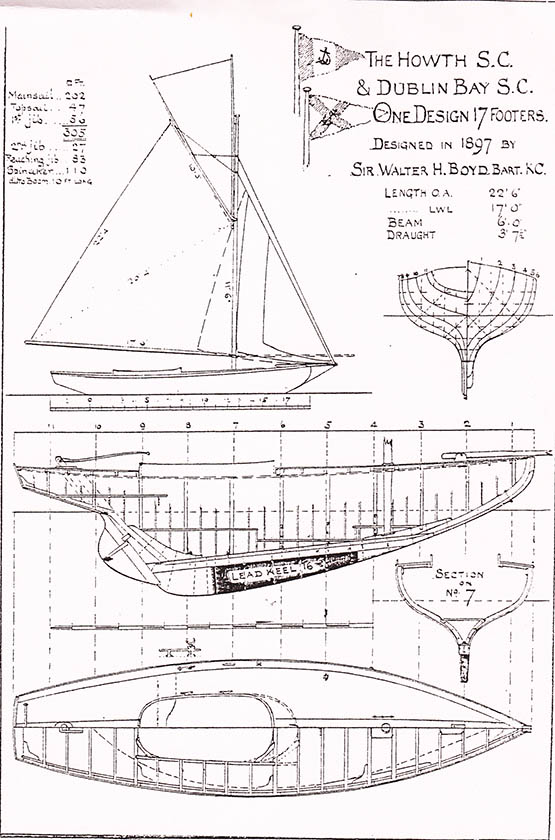
For nine years it trundled along perfectly happily as the Howth 17, but then in 1907 Dublin Bay SC got in on the act, and by 1912 most of the world knew it as the Dublin Bay 17.
Fair play, though, in the 1930s it was DBSC off its own bat which got the 17ft John Kearney-designed Mermaids going, eventually becoming Ireland’s most popular class. And then in the late 1930s, they began working on an original idea which in 1947 manifested itself as the Mylne-designed Dublin Bay 24, an elegant Bermudan-rigged yacht which could give a good account of herself inshore and offshore, so much so that in 1963 one of them, Stephen O’Mara’s Fenestra, was overall winner of a very stormy RORC Irish Sea race.
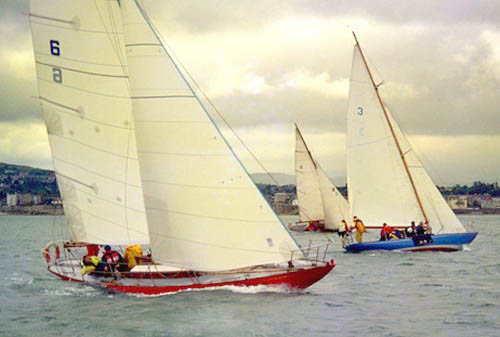
The queens of Dublin Bay. For fifty years from 1947 to 1997, the Dublin Bay 24s were the premier class on the bay. Photo: W M Nixon
Yet by that time, standardization and series production by glassfibre construction was taking over the scene. Some Dublin Bay 24 owners dabbled in the idea of a new OD class based on the van de Stadt-designed Excalibur 36, which could be built so totally in plastic that some examples didn’t have any wood at all.
But maybe it was a step too far. The Excaliburs never quite took off. With hindsight, we can see that perhaps a less ambitious and more orthodox glassfibre cruiser-racer like the Nicholson 32 might have rung more bells. However, such was the continuing progress and growth of Dublin Bay SC that it didn’t matter either way. With the club’s exceptional adaptability, it was more than happy to leave the promotion of boat types to the expanding commercial sector, and continue to do what it does best – organise racing in Dublin Bay in a user-friendly way in which time afloat is maximized for sporting value.
It results in the Bay being a great sporting arena, and also a laboratory of sailing success. It’s fascinating to note, for instance, that the Flying Fifteens – which are virtually entirely a National Yacht Club fleet – are vying with the Water Wags for being the most numerous class on Dublin Bay, and they’re certainly the biggest keelboat fleet.

With a very enthusiastic local class association, the Flying Fifteens are successfully demonstrating what it takes to be the largest keelboat class on Dublin Bay. Photo: David O'Brien
As for the adoption and adaptation of new ideas and concepts first developed by others, this moved on to a new plane just a few weeks ago when it was announced that Dublin Bay Sailing Club had amalgamated with the Royal Alfred YC. With its origins way back in 1857, the Alfred pioneered the notion of total Corinthian – ie amateur – sailing in Dublin Bay, though as a reflection of the Victorian era in which it functioned, the rule did allow your ship’s company to include two “paid hands” – a steward and a lady’s maid.
The active minds of the club’s promoters soon went on to codifying the racing rules, which were extremely rudimentary – where they existed at all – in the middle of the 1800s. By the 1860s, the need for clarification had become so pressing that when a move arose to set up a national authority for sailing rules in in the United Kingdom – of which Ireland was then part – it was the Royal Alfred YC which played a leading role, and basically its existing rules became the foundation on which the racing rules of the Yacht Racing Association – now the UK’s Royal Yachting Association – were based way back in 1870-71.
But with this achieved, the new club which had been such a thorn in the flesh of the sailing establishment was now the Royal Alfred YC and part of the sailing establishment itself. A fresh wave of new blood was needed, and that came with the formation of Dublin Bay Sailing Club in 1884.
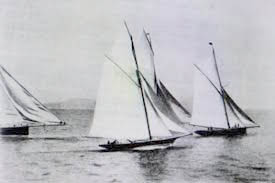
A Royal Alfred YC cross-channel match in 1888. This historic pioneering club has now been amalgamated into Dublin Bay SC.
Both they and the RAYC continued to function successfully, organising and regulating races as “virtual” clubs, entirely without premises, for a hundred years and more. But the changing patterns of sailing meant that over the decades the Royal Alfred YC became less relevant, while the Dublin Bay Sailing Cub came quietly centre stage. And now, with the incorporation of the Royal Alfred – in which the utterly straightforward name of Dublin Bay Sailing Club is inevitably the dominant partner – we see the apotheosis of the way in which DBSC confidently takes on board and re-energises the visions of others.
Looking to the season ahead, in order to cope with the numbers and the diversity, DBSC is providing racing on five days per week, and on the more popular evenings, the turnout is such that they are in effect organising two regattas per week. The total between the rigs and the roundabouts is something like 800 starting sequences organised each season.
The basis of it all is in a large corps of volunteers. Fortunately for the more casual sailors on the bay, and for those for whom there is just the one weekly sailing outing as a crew on a cruiser in the huge evening programmes, there seems to be a distinct strand of the South Dublin sailing population which feels the call to help in the mountain of work involved afloat and ashore in keeping the DBSC programme running smoothly.
That said, this is essentially sport for those who realize that you’ll only get as much out of it as you put into it. Classes will be encouraged, but only up to a point – after that, they’re expected to show a certain level of self-sufficiency, and in the countdown to the new-look progamme for 2016 (which was revealed yesterday afternoon on Afloat.ie) a series of meetings have been held involving different group leaders such as Class Captains in order to ensure that the message of being transferred down the chain of communication.
But even the most quintessentially volunteer-based organisation can always use a bit of extra financial muscle, so the Sherry Fitzgerald sponsorship is both a very comfortable fit, and extremely welcome. It will allow the DBSC admin team a bit of extra breathing space, but it’s doubtful if it will provide them with a less demanding schedule.
New Commodore Chris Moore is no stranger to the demands of being top man in a large sailing organisation, as he was Commodore of the National YC from 2002 to 2005 – an exciting time as the Irish economy was beginning its crazy flight through the roof.
Back then, he was still working in a busy career. But now he is retired. Yet he cheerfully tells us that being Commodore of Dublin Bay SC is more time-consuming and all-absorbing than the combined challenges of being NYC Commodore and having a full-time day job. And on top of all that, he still has to find the time and energy for the vigorous campaigning of his J/109 Powder Monkey. That’s how it is with the people fully involved in running Dublin Bay Sailing Club.
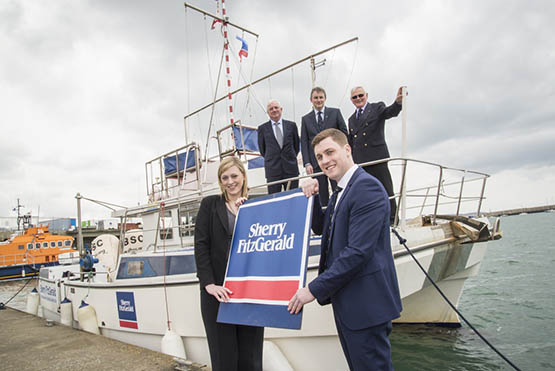
The new Sherry Fitzgerald standard is now aloft on Dublin Bay. Miriam Mulligan and Chris Corrigan are foreground, while aboard Mac Lir are Philip Sherry of Sherry Fitzgerald with DBSC Vice Commodore Jonathan Nicholson and DBSC Commodore Chris Moore. Photo: Brendan Fogarty.


